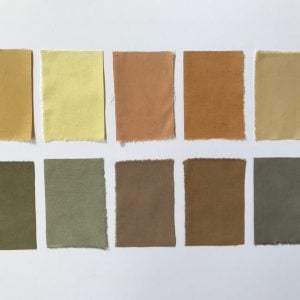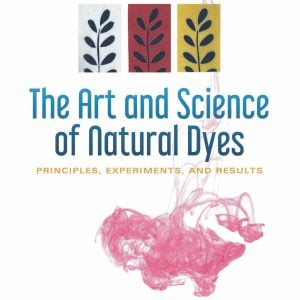
Mordant Monday this week is all about questions: some are mordanting questions and others are the victims of spellcheck.

I changed my mind
How do I change a mordant after the fact? I have some wool and cotton fabrics with alum on them but I really want to have them mordanted with iron instead. Can I remove the alum and start with an iron base?
Answer: Alum mordants are very durable and long-lasting bonds, and while there are a few substances that can weaken or damage them, using them would probably also damage the fabric and we don’t recommend this at all. My suggestion is to add the iron as a separate step. You can add it at one of three points in the immersion dyeing process.
- Immerse the fabrics in an iron mordant and then proceed to dyeing.
- Add the iron to the dye bath, then immerse the alum-mordanted fabrics and dye.
- Make a separate iron post bath and dip the dyed fabrics in iron after the dye process is complete.
We have found that using iron in the dye bath vs. dipping the dyed fabric in an iron bath makes a difference in the color. Experiment and see which method you prefer.
Mordant bath turned grey
I recently used your Gallo Tannin for the first time. After using it to mordant some fabric the bath turned grey. Is this normal? What would cause that? I use well water, is it possibly something in the water? And do you think I can use it after it’s turned grey?
Answer: A gray solution usually means that there is iron present in the water. Well water can contain iron and so can rusty water pipes. Iron reacts with tannin (it’s called the iron-tannate reaction) and produces light to dark gray. If you are seeing a light gray tinge, you should be okay to continue using it. If it’s very, very dark then you might want to consider a different water source, or alternatively, do some tests and see if you like the results. Iron makes colors “darker” and may enhance reds to a more burgundy shade and bright yellows to chartreuse and light green, so it can be very handy to create richer shades with minimal effort.


Boiling my cat
I have a 1-2-3 indigo vat that is about 40 gallons and accidentally turned on my stove and boiled it all night. There were about 5 gallons left. I added water to the vat and added fructose but the foam and flower are now brownish- cream. Is it ruined? I used a lot of indigo!
Answer: I’m relieved we’re talking about indigo and not some poor pet! Unfortunately, a long boil probably degraded the indigo and broke it down, and the brown color could be the other indigo colors that are present in the pigment. According to my sources, the vat is beyond repair.



